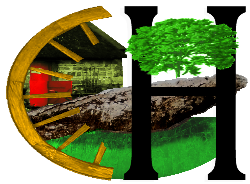


The forge was a dimly-lit, usually medium-sized house. There was no machinery - the smith made his own tools, consisting of an anvil, a vice, bellows turned by a hand crank, tongs, rake and poker for the fire as well many welding and shoeing tools.
The blacksmith produced all the tools needed in the community. His trade was usually hereditary, being handed down from father to son often tracing back five or six generations. A smith 100 years ago could make up to 100 different items while his grandfather could have made 200, including weapons for hunting and warfare.
The blacksmith would hammer the red hot metal into shape on the anvil, which was mounted on a wooden block to absorb the impact. Under the hearth was a water trough in which the smith cools his irons.
The blacksmith was considered one of the most important tradesmen in the community. His services were required by practically everybody. Whether it was for shoeing a horse, making a gate, plough irons, spades, shovels, sleáns, scythes and putting iron tyres on cartwheels or making and repairing farm implements. He was both a farrier who shod and cared for horses and a manufacturer & repairer of agricultural implements.
'Shoeing' wheels was one of the blacksmith's important jobs. A strip of iron was cut, shaped and welded together, just a little smaller than the wheel. A circular fire was made, of peat, on the ground outside the forge, and the iron band was placed in it. When red hot, it was taken up with tongs and placed upon the wooden wheel, where it was quickly hammered into place whilst buckets of water were poured over to prevent the wheel from catching fire.
The forge was the central focal point of village life for centuries. It was a meeting place for men and boys, where news was exchanged and the politics of the day discussed. The blacksmith was a mine of information on local family history and news from around the country as travellers often called to his door. The blacksmith was usually a very good story teller or Seanchaí. He would keep you in suspense as he told it, striking the anvil every so often as to confirm it was true.
Passers-by would drop in for a chat, so the forge was never without a group of men and boys, some of them waiting their turn with a piece of work for the smith, and others just passing the time away. Women very rarely came to the forge and if they came with some job for the smith, they hardly ever entered and usually went away quickly.
No blacksmith had difficulty in gathering a group of neighbours to till his garden and woe betide anyone who refused to help when asked, thereby taking the smith away from his more important work in the forge. To help the smith to remain in his forge working, the community formed a Meitheal (working party) to help on his land. They cut hay and turf. Many small mending jobs were done in exchange for produce from local farms. The head of any animal killed was brought to the smith.
The blacksmith was both respected and a feared member of the community. It was well known that he could lay charms and spells, though always for a good purpose, such as the cure of illness. He worked all day with iron, and it was common knowledge that iron was a safeguard against the powers of evil. He could undo the evil spells laid to steal the produce from fields or the butter from the dairy; this was achieved by sprinkling of the forge water, accompanied by the appropriate words which were known only by him.
The smith wasn’t just the local metalworker; he also acted as dentist in the days gone by. A person with severe toothache would visit the blacksmith’s forge and have the tooth out. This was done by tying a piece of strong string to the tooth and also the anvil. The smith then gave a red hot piece of metal to the sufferer who jerked away in horror and pulled his own tooth out. Some smiths pulled teeth with their fingers or the horse-shoe tongs.
There was a cure for warts and other skin ailments in the water from the cooling trough provided the skin wasn’t open. Some also believed if the same water were applied to a squinty eye three mornings in a row, even without the smith’s knowledge, it would cure the squint. The smith also treated horses. Saddle-sores and bruises were treated with washes, using the water from the trough, and he could flush out a horse’s nose with a syringe made from a pig’s bladder. And some were believed to have the power to mete revenge by turning the anvil while cursing the person who had done the wrong.
The good smith was said to have an eye sharper than the tailor’s measure. He could tell at a glance the length of iron required for the band of a wheel or the exact height of a horse or pony by looking at them or their age by a glance at their teeth. He was a patient craftsman; such tasks as making an iron gate might take a couple of hours of unbroken work, and seldom did that length of time pass without some customer coming with an urgent job.
The smith often had a standing arrangement by which he gave regular service in shoeing horses and repairing equipment for the farmers in return for regular deliveries of farm produce such as oats, potatoes, flour, vegetables. Others paid him the fair day he went early to the fair and the farmers settled up with him when they sold.






















